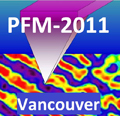Arthur P. Baddorf |
Arthur P. Baddorf is a Senior R&D staff member and Group Leader for the Imaging Functionality scanning probes group at the Center for Nanophase Materials Sciences at Oak Ridge National Laboratory. Since graduating from the University of Pennsylvania in 1987, he has authored over 100 articles and book chapters on experimental studies of electronic, vibrational, structural, chemical and transport properties of low-dimensional materials at a fundamental level. His recent focus has been on the science of thin film oxides, with projects exploring atomic scale structure and electronic transport in perovskite ferroelectrics. Much of this work has been enabled by the NanoTransport system he has constructed to combine pulsed laser deposition synthesis with in situ electron spectroscopies and variable temperature AFM and STM. |
|
Center for Nanophase Materials Sciences, Oak Ridge National Laboratory, Oak Ridge, TN, 37831 |
||
Topological Size Effects in Electron Transport through Ferroelectric Surfaces A recent burst of nanoscale electron transport measurements has rapidly advanced the concept of ferroelectric tunneling into experimental realm. Polarization-controlled transport effects have been detected in tunnel junctions, thin films, single crystals and at domain walls. Yet, virtually no attention has been drawn to finite dimensionality of domains as well as the field-induced dynamics of ferroic topological defects as a possible source of new transport phenomena.
We will present seminal experimental observations of such effects on thin films of Pb(Zr0.2Ti0.8)O3 (PZT) and BiFeO3 (BFO). Earlier we have shown that both materials exhibit pronounced polarization-controlled electroresistance [1]. Upon closer inspection, the I-V curves have revealed a reproducible region of negative differential conductance following ferroelectric switching. Although this anomaly may originate from extrinsic processes, e.g. due to oxygen vacancies or charge injection, we have carried out a series of control experiments (most notably with non-linear bias waveforms to probe local conductance) that unequivocally point to variation of conductance with the size of the polarization domain in plane of the surface (2). The I-V anomaly therefore arises from a comparatively slow expansion of the domain following polarization switching, and significant conductivity of the domain wall in lead zirconate. Subsequently we have shown that by tuning the built-in field through the epitaxial composition, it is possible to reverse the domain expansion in a highly controlled way, and probe a quasi-continuous spectrum of domain dimensions. The resulting, tunable conductance is closely reminiscent of analogue memristors, providing a quasi-continuous spectrum of non-volatile resistive states, even though polarization in PZT is bistable. Ferroic memristive behavior, which based on our measurements is likely to be universal to ferroic smiconductors, is a striking departure from the conventional picture of discrete electron transport states in ferroelectrics. In addition to continuously tunable memory elements and the possibility of directly mimicking neuromporphic spike-time dependent plasticity, there arises a possibility of new transport properties controlled by secondary parameters localized to topological defects. We will also discuss how memristive behavior can occur within the domain walls themselves, using 109o ferroelectric domain walls in BiFeO3 as a model system (3). Research conducted at Center for Nanophase Materials Sciences, sponsored by Division of Scientific User Facilities, U.S. Department of Energy. (1) Maksymovych et. al, Science 324 (1421) 2009 (2) Maksymovych, Yu, Ramesh, Baddorf, Kalinin, “Topological Size Effects in Polarization Controlled Electron Transport through Pb(Zr0.2Ti0.8)O3 Thin Films”, (2010) subm. (3) Maksymovych, Seidel, Wu et. al, Polarization-induced Conductivity and Memory Effects at Ferroelectric Domain Walls, Nat. Mat. subm. (2010). |
||
|







